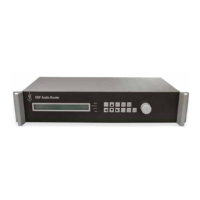
Do you have a question about the ASL INTERCOM VAR8 and is the answer not in the manual?
| Brand | ASL INTERCOM |
|---|---|
| Model | VAR8 |
| Category | Controller |
| Language | English |
Provides critical safety and operational guidance for system use.
Lists necessary tools and components for system operation and setup.
Identifies the software versions used in the VAR8 system.
Ensures all configuration tasks are completed for compliance.
Describes the function of front panel controls and indicators like LEDs.
Details procedures for logging into and out of the system.
Explains the system's menu structure and navigation methods.
Covers selecting items, changing options, and using the rotary encoder.
Explains the behavior of screen timeouts and user inactivity.
Provides a visual representation of the system's menu hierarchy.
Step-by-step procedure for gaining access to the system.
Procedure for safely exiting the system.
Describes the different network configurations supported by the system.
Details the setup and characteristics of the 4x4 ACU network.
Details the setup and characteristics of the 8x8 ACU network.
Configures units acting as slaves within the network.
Configuration settings for the main Audio Control Unit.
Assigns types and names to microphone and audio inputs.
Sets the emergency status for system inputs.
Adjusts gain, EQ, and other audio parameters for inputs.
Defines input priorities for output conflict resolution.
Configures backup audio sources for local inputs.
Programs the functions of microphone buttons.
Specific configuration for paging and fire microphones.
Sets buttons to an inactive state to prevent accidental operation.
Configures buttons for selecting audio routing zones.
Configures buttons for routing DVA or other audio sources.
Configures buttons to play DVA messages to selected outputs.
Configures buttons to activate the all-call function.
Configures buttons to stop all DVA playback.
Configures buttons for single-button microphones.
Sets unused inputs to 'Unused' to prevent fault reports.
Assigns names to DVA inputs for identification.
Sets the emergency class for DVA inputs.
Adjusts audio gain and parameters for DVA inputs.
Defines priority levels for DVA inputs.
Assigns types and names to music inputs.
Sets the emergency class for music inputs.
Adjusts audio gain, EQ, and fade parameters for music inputs.
Defines priority levels for music inputs.
Sets the emergency class for mute inputs.
Defines priority levels for mute inputs.
Configures triggers using digital inputs from Remote I/O units.
Details connecting ANS sensors to remote I/O unit inputs.
Configures outputs to be controlled by ambient noise levels.
Configures inputs for ambient noise compensation.
Configures router digital inputs to report external faults.
Configures remote I/O digital inputs as external faults.
Configures remote I/O analogue inputs as external faults.
Procedure to change the system access code.
Setting and managing the system's date and time.
Assigns a name to identify the system installation.
Controls the fault sounder behavior during announcements.
Sets timeout for host-initiated route clearing.
Configures over-temperature alarms for the system.
Resets system configuration to factory default settings.
Displays the current software versions of system components.
Configures serial port settings for connectivity.
Checks the current signal routing status within the system.
Checks the physical state of system contacts.
Monitors values from ambient noise sensors.
Monitors audio signals via speakers and bargraph displays.
Tests front panel LEDs and the system sounder.
Provides functions for testing amplifier frames.
Tests the switchover functionality to standby amplifiers.
Displays and explains amplifier DIP switch configurations.
Checks the status of the system's battery.
Monitors the battery voltage while connected to the charger.
Checks voltage levels on the power supply channels.
Monitors the voltage output from the charger.
Checks the ambient temperature within the amplifier frame.
Identifies the type and software revision of installed amplifiers.
Displays detailed status information for amplifiers.
Monitors audio path surveillance tones for amplifiers.
Checks the DC line status and spur count for amplifiers.
Monitors earth leakage readings for amplifier circuits.
Establishes communication between PC and configuration tool.
Procedure for creating a new system configuration.
Retrieves configuration data directly from the VAR8 unit.
Imports a saved configuration file into the system.
Backs up the current configuration to a text file.
Transfers configuration changes to the VAR8 unit.
Detailed explanation of the system's menu items and settings.
How faults are displayed and indicated on the system.
Procedures for acknowledging and stabilizing fault indicators.
Steps to clear active faults after they are resolved.
Displays a list of all currently active faults.
Accessing and managing the system's fault logs.
Guides for diagnosing and troubleshooting system faults.
Lists common faults and their suggested corrective actions.
Faults specific to amplifier frames and their components.
Interpretation of numerical fault codes for diagnosis.
Emphasizes the importance of trained and qualified personnel for maintenance.
Requirements for logging installation and maintenance activities.
Detailed procedures for system maintenance.
Periodic inspection and testing schedule for the system.
Procedure for replacing the unit's real time clock battery.
Actions to take following a fault or fire incident.
Post-fire inspection and reporting procedures.
Steps to take when a system fault is detected.
Procedures for restoring system default settings.
Resets the system access code to its default value.
Resets all system configurations to factory defaults.
Summary of the system's default configuration parameters.
Configures link settings for standalone or specific network modes.
Guidelines for the operating environment and conditions.
Measures to prevent damage from electrostatic discharge.
Ensures electromagnetic compatibility through proper wiring.
Safety measures for electrical operations and power supply.
Safety guidelines for handling and replacing lithium batteries.
Safe procedures for unpacking, inspecting, and handling equipment.
Details conditions not covered by the product warranty.